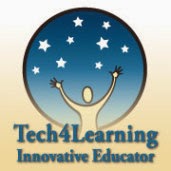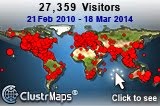This reminds me of the very first day of my very first class in my teacher training program. We were instructed that we had better become very aware of the truth that one teaches what one values. You can teach curriculum, but always, you teach from who you are. And who you are is what you value.
So, back to educational free choice. The choices reflect what I believe to be educational because it is my classroom. The students are welcome to suggest or show me anything as long as they can explain to me its educational value.
Frequently, I am asked, "Why is GarageBand educational?" or "Why is the National Gallery of Art site educational?"
I think by this point, the answer is obvious: I value creativity. I value it highly and I think it is an extremely important component of learning and personal development. Without creative thinkers, where would the world be?
It troubles me that the students are so surprised to find that the creative arts are considered by a teacher to be valid educational pursuits. It makes me think of this video I recently saw, "Do Schools Kill Creativity?". It is long, but worth a look.
In my years as an educator, I have seen an alarming movement away from valuing the creative arts and creative expression in general. This is just wrong. It is based in a totally wrong way of thinking. That is not just my value-judgement. There is plenty of good research in defense of creativity and its place in schools. However, I still hear all the time, that subjects like art and music are "extras" and that only academics matter.
The good news is that creativity in education is finally getting some respect. ISTE, the International Society for Technology in Education, which writes the standards for technology, not only added "creativity and innovation" to its NETS for students for 2007, it placed them in the number one position.
“What students should know and be able to do to learn effectively and
live productively in an increasingly digital world ...”
1. Creativity and Innovation
Students demonstrate creative thinking, construct knowledge, and develop innovative products and processes
using technology. Students:
a. apply existing knowledge to generate new ideas, products, or processes.
b. create original works as a means of personal or group expression.
c.. use models and simulations to explore complex systems and issues.
d. identify trends and forecast possibilities.
The history of educational theory closely reflects what is going on in society. Most of the current thinking in education favors a constructivist approach which requires students to construct knowledge for themselves, to discover anew rather than to regurgitate what others have found. This befits this time in history, where information is prevalent and technology is changing at a lightning pace. The future belongs to and depends on those who can think outside the box. You don't get that type of thinking from students who have only been taught to do well on tests.
“What students should know and be able to do to learn effectively and
live productively in an increasingly digital world ...”
1. Creativity and Innovation
Students demonstrate creative thinking, construct knowledge, and develop innovative products and processes
using technology. Students:
a. apply existing knowledge to generate new ideas, products, or processes.
b. create original works as a means of personal or group expression.
c.. use models and simulations to explore complex systems and issues.
d. identify trends and forecast possibilities.
The history of educational theory closely reflects what is going on in society. Most of the current thinking in education favors a constructivist approach which requires students to construct knowledge for themselves, to discover anew rather than to regurgitate what others have found. This befits this time in history, where information is prevalent and technology is changing at a lightning pace. The future belongs to and depends on those who can think outside the box. You don't get that type of thinking from students who have only been taught to do well on tests.
That is why GarageBand and art programs are part of educational free choice in my neck of the woods. Now, if the students could give such coherent arguments for their arcade games I just might let them play those, too.


 3 Simple Meme Rules:
3 Simple Meme Rules:








